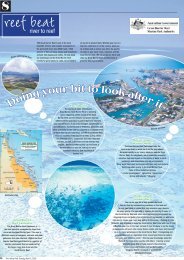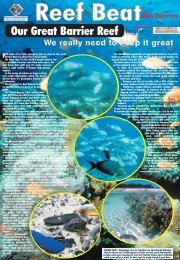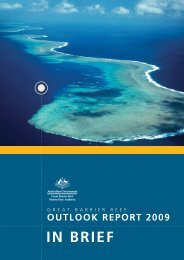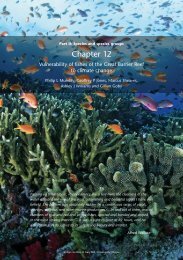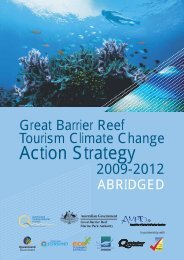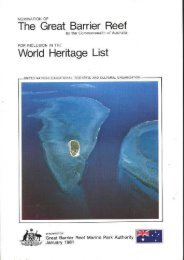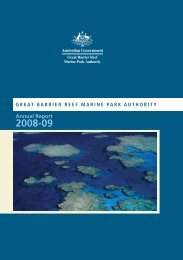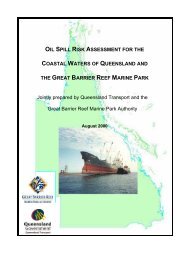Coral Bleaching Response Plan - Great Barrier Reef Marine Park ...
Coral Bleaching Response Plan - Great Barrier Reef Marine Park ...
Coral Bleaching Response Plan - Great Barrier Reef Marine Park ...
You also want an ePaper? Increase the reach of your titles
YUMPU automatically turns print PDFs into web optimized ePapers that Google loves.
Introduction<br />
Large-scale coral bleaching events, driven by unusually warm sea temperatures, have now affected<br />
every major coral reef ecosystem on the planet (Wilkinson 2004). The effects of coral bleaching are<br />
pervasive, and potentially devastating to ecosystems and the people and industries that depend upon<br />
them. The frequency and severity of these large-scale disturbances is predicted to increase as<br />
temperatures continue to warm under a global regime of climate change. Climate change in<br />
combination with the multitude of other stressors resulting from human activities is leading to<br />
unprecedented pressure on coral reefs. Understanding the effects and implications of coral bleaching,<br />
and identifying strategies to reduce stress and mitigate impacts, are urgent challenges for the<br />
conservation and management of coral reefs worldwide.<br />
The <strong>Great</strong> <strong>Barrier</strong> <strong>Reef</strong> <strong>Marine</strong> <strong>Park</strong> has experienced two major coral bleaching events in recent years:<br />
1998 and 2002. The spatial extent of these events, combined with the high level of mortality seen at<br />
severely affected sites, has lead to widespread concern about the future of the <strong>Great</strong> <strong>Barrier</strong> <strong>Reef</strong> in the<br />
face of global climate change. The <strong>Great</strong> <strong>Barrier</strong> <strong>Reef</strong> <strong>Marine</strong> <strong>Park</strong> Authority’s (GBRMPA) <strong>Coral</strong><br />
<strong>Bleaching</strong> <strong>Response</strong> <strong>Plan</strong> has been developed to provide an early warning system for conditions that are<br />
conducive to coral bleaching, and to document the extent and severity of coral bleaching events using<br />
broad-scale synoptic surveys and ecological surveys. The information collected under this <strong>Response</strong><br />
<strong>Plan</strong> can be used to compare and analyse the frequency and patterns of bleaching events and to develop<br />
forecasting tools.<br />
1. <strong>Plan</strong> Overview<br />
This document describes a <strong>Coral</strong> <strong>Bleaching</strong> <strong>Response</strong> <strong>Plan</strong> for the <strong>Great</strong> <strong>Barrier</strong> <strong>Reef</strong> (GBR). This will<br />
enable GBRMPA to:<br />
• Develop a system to forecast coral bleaching events;<br />
• Provide early warnings of a major coral bleaching event;<br />
• Measure the spatial extent and severity of mass coral bleaching events;<br />
• Assess the ecological impacts of mass coral bleaching events;<br />
• Involve the community in monitoring the health of the GBR;<br />
• Communicate and raise awareness about coral bleaching and climate change impacts on the GBR;<br />
• Provide information to evaluate the implications of coral bleaching events for management policy<br />
and strategies.<br />
The <strong>Great</strong> <strong>Barrier</strong> <strong>Reef</strong> <strong>Coral</strong> <strong>Bleaching</strong><br />
<strong>Response</strong> <strong>Plan</strong> (the <strong>Response</strong> <strong>Plan</strong>) has<br />
been developed in conjunction with A<br />
Global Protocol for Assessment and<br />
Monitoring of <strong>Coral</strong> <strong>Bleaching</strong> (WWF,<br />
FishBase and GBRMPA), A <strong>Reef</strong><br />
Manager’s Guide to <strong>Coral</strong> <strong>Bleaching</strong> (an<br />
international collaborative effort lead by the<br />
US <strong>Coral</strong> <strong>Reef</strong> Task Force and GBRMPA)<br />
and to maximise comparability and<br />
consistency with bleaching response plans<br />
in other regions. The <strong>Response</strong> <strong>Plan</strong> also<br />
links in with GBR tourism industry-based<br />
monitoring programs such Eye on the <strong>Reef</strong>.<br />
The GBR <strong>Coral</strong> <strong>Bleaching</strong> <strong>Response</strong> <strong>Plan</strong><br />
has the following three main components<br />
(Figure 1):<br />
• Early Warning System<br />
• <strong>Bleaching</strong> Assessment and Monitoring<br />
• Communication Programme<br />
Figure 1. Schematic overview of GBR <strong>Coral</strong> <strong>Bleaching</strong><br />
<strong>Response</strong> <strong>Plan</strong> elements<br />
GBRMPA <strong>Coral</strong> <strong>Bleaching</strong> <strong>Response</strong> <strong>Plan</strong><br />
<strong>Coral</strong> <strong>Bleaching</strong><br />
Early Warning System<br />
Climate Monitoring<br />
Sea Temperature<br />
Monitoring<br />
BleachWatch<br />
<strong>Bleaching</strong> Assessment<br />
and<br />
Monitoring Programme<br />
Broad-scale synoptic<br />
surveys<br />
<strong>Bleaching</strong> surveys<br />
Communication Programme



